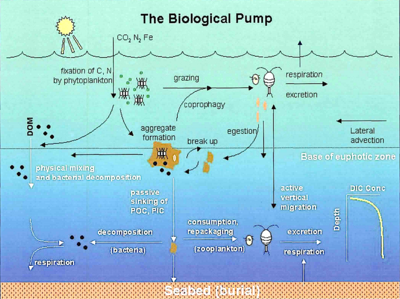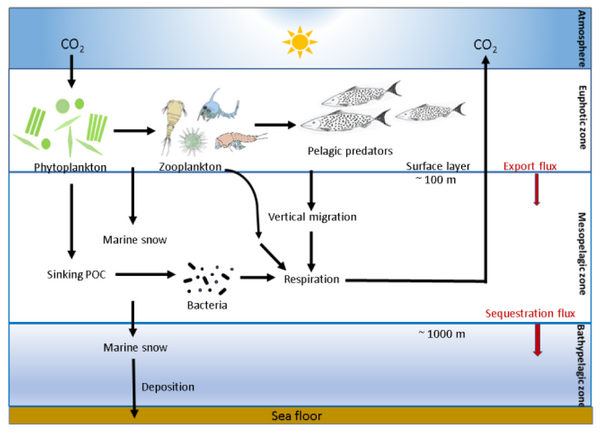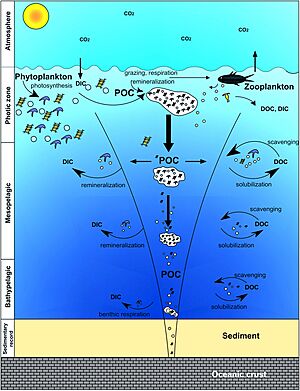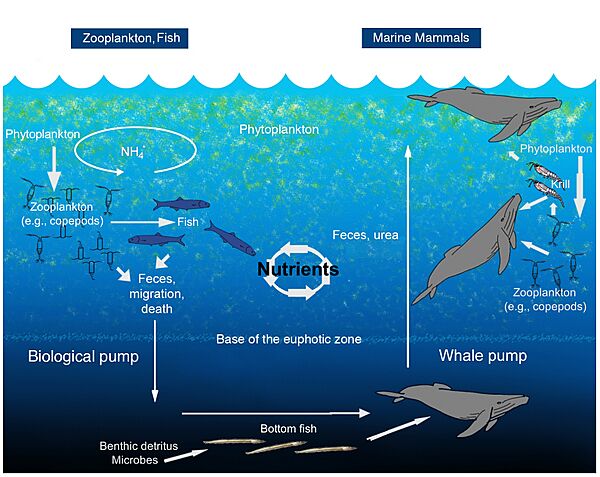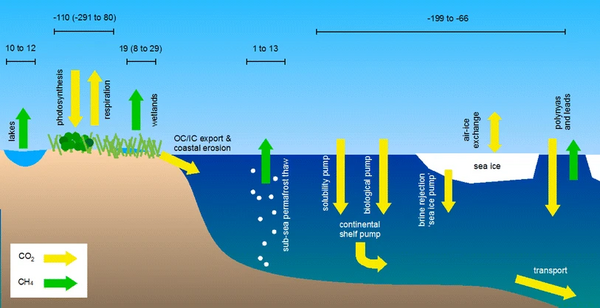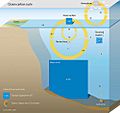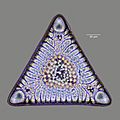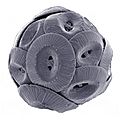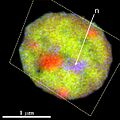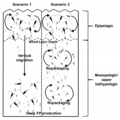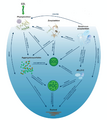Biological pump facts for kids
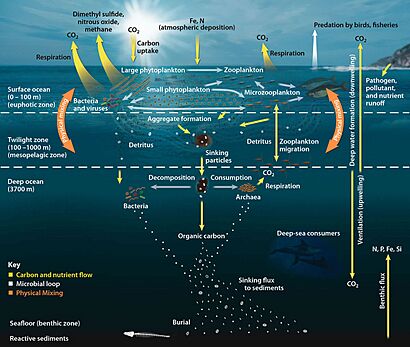
The biological pump is a natural process in the ocean that moves carbon from the surface down to the deep sea. Think of it like an elevator for carbon! This process is driven by tiny living things, especially ocean plants called phytoplankton.
The biological pump is a very important part of the Earth's carbon cycle. It helps control the climate by trapping carbon deep in the ocean. This keeps it out of the atmosphere for hundreds or even thousands of years. Without this pump, the amount of carbon dioxide in our air would be much higher, making the planet warmer.
Contents
How the Pump Works
The biological pump is not just one single process. It is the sum of many different processes that work together. Overall, the pump moves about 10.2 billion tons of carbon into the deep ocean every year.
The pump works in three main phases:
- Making Food: In the sunny surface waters, phytoplankton use photosynthesis to turn carbon dioxide into food.
- Sinking: When these tiny plants and the animals that eat them die, they sink. This sinking material is often called marine snow.
- Recycling: On the way down, or on the seafloor, bacteria break down the sinking material. This releases the carbon and other nutrients, which can then be used again.
Carbon that gets buried in the seafloor sediment is trapped, or sequestered. This is what helps lower the amount of carbon dioxide in the atmosphere over long periods.
Marine Snow: The Carbon Express
Most of the carbon used by ocean life is at the surface. When these organisms die, they start to sink. The deep ocean gets most of its food from this sinking material, which is called marine snow.
Marine snow is made of dead plants and animals, poop, sand, and other bits. A single phytoplankton cell sinks very slowly and might take years to reach the ocean floor. However, these bits often clump together to form larger aggregates. These clumps of marine snow sink much faster, sometimes reaching the bottom in just a few days. This is the main way carbon is carried from the surface to the deep ocean.
About 10% of the carbon from the surface makes it out of the top layer of the ocean. Less than 1% of the carbon actually reaches the seafloor to be buried. Most of it is eaten or broken down by other creatures on the way down.
The Role of Tiny Animals
Zooplankton are tiny animals that drift in the ocean. They are key players in the biological pump. They eat phytoplankton and package the carbon into dense fecal pellets (poop). These pellets sink much faster than the phytoplankton alone. This helps move carbon into the deep ocean very efficiently.
Many zooplankton also help by moving up and down in the water each day. This is called diel vertical migration. They often feed near the surface at night, where the food is. Then, they swim down to the darker, deeper waters during the day to hide from predators.
When they release their waste deep in the ocean, they give that carbon a huge head start on its journey to the seafloor. This is called active transport because the animals are actively moving the carbon to the deep.
More Than One Kind of Pump
The biological pump is the most well-known, but it works alongside other ocean pumps that also move carbon.
The Solubility Pump
The solubility pump is a physical and chemical process. It works because carbon dioxide dissolves more easily in cold water than in warm water.
In cold parts of the world, like near the poles, surface water gets very cold and dense. This cold water absorbs a lot of CO2 from the atmosphere before it sinks into the deep ocean. This process pumps a large amount of carbon into the ocean's interior without any help from living things.
The Carbonate Pump
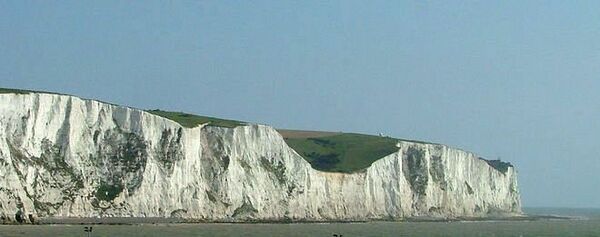
The carbonate pump is sometimes called the "hard tissue" pump. Some ocean creatures, like coccolithophores and foraminifera, build protective shells out of calcium carbonate. This is the same material that makes up chalk and limestone.
When these organisms die, their hard shells sink to the ocean floor. This process locks away carbon in the form of calcium carbonate. Over millions of years, these shells can build up to form thick layers of sediment, which can later become rock. The famous White Cliffs of Dover in England are made from the shells of countless tiny coccolithophores.
Big Helpers: Whales and Jellies
It's not just tiny creatures that help the carbon pump. Some of the ocean's largest animals also play an important part.
The Whale Pump
Whales help the biological pump in a unique way. They often feed deep in the ocean but return to the surface to breathe. At the surface, they release huge plumes of poop.
This whale poop is full of nutrients like nitrogen and iron. These nutrients act like fertilizer for phytoplankton, helping them grow and take up more carbon. When a whale dies, its massive body sinks to the ocean floor. This event, called a whale fall, delivers a huge amount of carbon and food to the creatures living in the deep sea.
Jelly-Falls
Jellyfish can also contribute to the pump. Sometimes, huge groups of jellyfish, called blooms, die all at once. When they do, they sink to the seafloor.
This event is known as a jelly-fall. It carries a large amount of carbon to the deep ocean. On the seafloor, the dead jellyfish become a big meal for deep-sea animals and bacteria.
How Climate Change Affects the Pump
Human activities, like burning fossil fuels, have released a lot of extra CO2 into the atmosphere. This is causing climate change, which can affect the biological pump in several ways.
- Ocean Warming: As the ocean's surface gets warmer, it forms a layer that doesn't mix well with the cold, nutrient-rich water below. This means less food for the phytoplankton at the surface. With less phytoplankton, the biological pump could slow down.
- Ocean Acidification: When the ocean absorbs CO2, the water becomes more acidic. This can make it harder for organisms like coccolithophores to build their calcium carbonate shells. If their shells are weaker, they may not sink as fast, which means less carbon would reach the deep ocean.
Scientists are still studying how these changes will affect the biological pump in the long run. Understanding this is key to predicting future changes in our planet's climate.
Images for kids
-
The beautiful glass shell of a diatom, a type of phytoplankton.
-
Coccolithophores help the carbonate pump by making hard shells that sink to the ocean floor.


